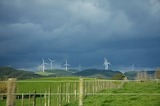
Unrestricted Use
CC BY
This is an extension lesson that will allow students to develop a better understanding of wind as a source of alternative energy. This activity will require students to construct and measure the energy production of a table-top wind turbine. This activity has been remixed from As the Rotor Turns: Wind Power and You" by CLEAN: Climate Literacy and Energy Awareness Network licensed under Custom License.Image Credit: "Raglan" by Natalia Volna itravelNZ@ travel app is licensed under CC BY 2.0
- Subject:
- Earth and Space Systems
- Force/Motion/Energy
- Material Type:
- Lesson Plan
- Author:
- Lindsey Layne
- Liz Ashby
- Corey Porter
- Date Added:
- 11/30/2019